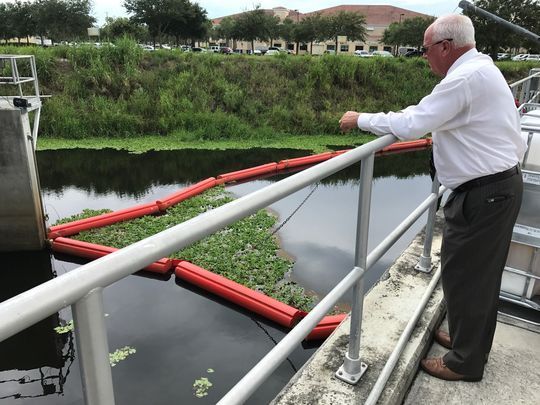"Shocking" Approach to Algal Bloom Prevention
Published on by Water Network Research, Official research team of The Water Network in Technology
A Michigan company, Greenfield Resources , is out to prove it can literally shock pollutants out of water entering the Indian River Lagoon.
Along the Main Relief Canal just north of Indian River County government offices, Greenfield Resources has set up a trailer full of plastic tubes and machinery the company says can remove nitrogen and phosphorus — contaminants that cause algae blooms — from canal water before it reaches the lagoon.
Here's a simplified version of how Greenfield’s system works:
- Canal water is pumped through plastic tubes called reactors, where it's hit with an electric current.
- The water passes through several catalysts (elements such as titanium and copper) that cause the pollutants to oxidize and float to the surface.
- Before the water is sent back to the canal, the floating pollutants are skimmed off onto large rolls of biodegradable paper.
The process makes any heavy metals and chemicals in the water inert, Taylor said, so the pollutant-covered paper can be sent to a landfill. Or the nutrients, which flowed into the canal as excess fertilizer, can be turned back into fertilizer.
The process is "a proven technology," said Duane De Freese, executive director of the Indian River Lagoon Council. "It's been used for years in various industries. Using it in an environmental restoration is an interesting application."

Image: Indian River County Commissioner Peter O'Bryan looks Tuesday at the site on the Main Relief Canal in Vero Beach where Greenfield Resources is cleaning water before it reaches the Indian River Lagoon.
Image credit: Tyler TREADWAY/ TCPALM
Will it scale up?
The Greenfield system might help stop algae blooms in the northern lagoon, but it would be overwhelmed by the onslaught of contaminants the St. Lucie River gets from Lake Okeechobee discharges, said Edward Phlips, an algae expert at the University of Florida Center for Aquatic and Invasive Plants.
Good tidal flow in the St. Lucie River estuary helps keep nutrient build-up at bay, at least until the discharges hit. “And then the discharges are such a massive event that holding back some nutrients probably won’t stop an algae bloom,” Phlips said.
But it might help stop blooms farther north, like the nutrient-fed brown tide that caused a massive fish kill in the Banana River in March 2016.
Source: TC Palm
Media
Taxonomy
- Environmental Health
- Algaecides
- Environment
- Algae
- Eutrophication
- Aquatic Environment
- Algae Treatment
- India
2 Comments
-
Bonjour
Bien entendu que l'on peut éliminer certains types de polluant avec des traitements adaptés.sauf que ces traitements adaptés ont un coût excéssivement onéreux. Pour le même prix ils n'éliment qu'une part infime de la pollution. La suppression de certaines pollutions ciblées auraont un impact sur le milieu développant une autre pollution peut être plus grave.
Hello of course that one can eliminate some types of pollutant with adaptes.sauf treatments these treatments adapted are excessively expensive. For the same price they éliment only a fraction of the pollution. The removal of some targeted pollution auraont an impact on the environment developing other pollution can be more serious.
-
Interesting technology, hope such innovations do work and can be scaled up, we shall need many of such solutions to prevent our rivers from dying.